Introduction to Characteristics of IoT
In this blog, we will discuss the Characteristics of IoT (Internet of Things) and other features; however, before getting into the let us know some interesting facts about the Internet of Things.
Kevin Ashton of MIT introduced the Internet of Things term in 1999. And then, LG introduced the first-ever smart fridge to the world in 2000, and 7 years later, the first iPhone was released. We all know that the internet of things is on the rise, and it is predicted that by 2030 there might be 29 billion devices connected to the internet.
What is IoT?
The term Internet Of Things has different definitions at different places. Some say it uses Data from machine to machine or human to machine to automate things and reduce human work. In a few other places, you will find that IoT is a technology that helps devices to build a global communication network by exchanging data through the internet and performing human work using that same data.
You can also watch a video on Characteristics of IoT on our Youtube page by Clicking Here
In my opinion, IoT is a way to connect multiple smart devices that use embedded technology to gather, store and send data from their surroundings. And through all these things, we can make machines work more smartly and efficiently. There are many characteristics of IoT that make it unique and very easy to use for users. Let us understand these characteristics of IoT below:
Characteristics of IoT (Internet of Things)
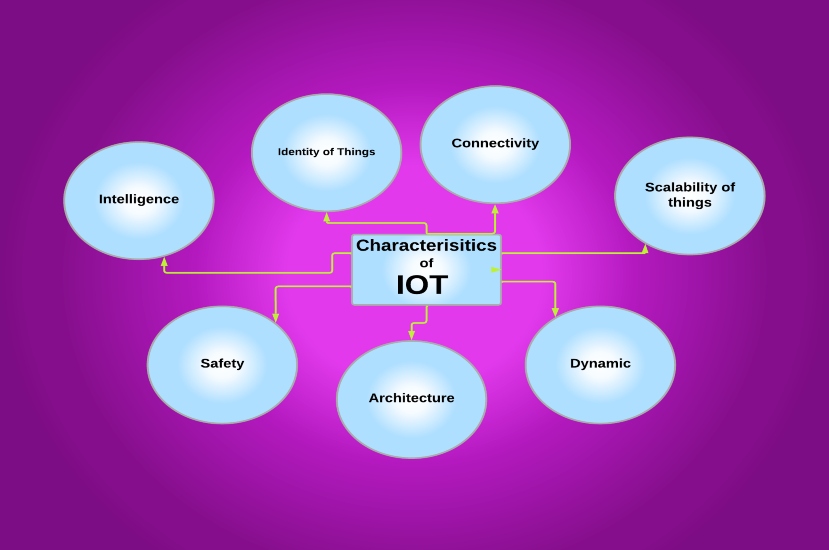
As discussed above, the Internet Of Things refers to the idea that different devices or items connected using the internet can communicate and share information. And with the help of this shared information, it can create new experiences for its users.
So, with the help of the below features, IoT creates unique experiences for its users:
1. Connectivity
As the name suggests, it’s all about the connectivity of 2 or more devices. This characteristics of IoT help to communicate with and share information between two or more devices. The IoT has created a world where everything is connected to communicate well and share user data. This connectivity also enables objects to be controlled remotely.
2. Identity of Things
As we all know, Identity is the unique characteristic of anyone. If we take the example of mobile, every mobile phone has a unique IMEI number, and the same goes for other devices in this world. Due to this unique number, we identify people and things on the Internet. So, we can say that the Identity of Things is one of the unique characteristics of IoT.
The concept of Identity is found in many aspects of IoT. Device Identity is the one thing that makes an IoT device unique and identifiable. Identity can be used to distinguish between different devices, give them a name, and allow them to be controlled.
3. Scalability
Scalability is nothing but the ability of a system to grow without affecting its performance of the system. We can quickly achieve that by adding more hardware resources or software layers to an existing system. IoT is increasing daily, and it is essential to consider scalability in your system, which makes it essential characteristics of IoT.
4. Dynamic or Self-Adapting
Being dynamic is one of the main characteristics of IoT because it needs to be self-adaptive to understand the changes around it and act accordingly. If we take an example of a camera, it was initially created just to take a photograph; however, later, it has got the feature of adjusting the quality of a photograph according to the light. So, being dynamic is very important to grow a system. Self-adaptability is a very important characteristics of IoT.
5. Architecture
Architecture is one of the critical characteristics of IoT, as with the increasing number of IoT devices, it is very important to keep it heterogenetic not homogenetic. IoT is only possible when multiple domains come together and work to build a system that can minimize human work. So, it is essential for the devices to support diverse technologies and protocols and communicate with each other.
6. Safety
The basic idea of IoT is to connect everything to the internet and make the system easier for the users. However, when things are connected to the internet in such a way there is always a danger of the sensitive personal details of the users getting compromised. So safety is undoubtedly a crucial characteristic of IoT.
7. Intelligence
The evolution of digital personal assistants like Alexa, Cortana, and Siri is an example of the intelligence of electronic devices. The intelligence of IoT devices is the intelligence of smart sensors and devices to sense data, interact with each other and collect a massive amount of data for analysis. It is very crucial for your IoT device to be smart and for that, you need to make sure that it is always up-to-date with the latest software and firmware. So, we can say that Intelligence is one of the essential Characteristics of IoT.
What are examples of IoT devices?
We all interact with IoT devices daily, even if we do not realize it. Let me help you with some examples of IoT devices used by us.
1. Sensors
Optical sensors for automatic street lights, sensors embedded in industrial machinery, sensors in office lights etc are a few of the best examples of sensors. Sensing things is one of the important Characteristics of IoT, as without sensing any problem statement, you can not fix it.
2. Security Devices
IoT-based security devices make it easy to monitor your home and business from anywhere. Intelligent home security cameras, audio recording devices, and sensor-based alarms are a few examples of IoT-based security devices.
3. Smart Home Devices
We all have smart home devices, which make our life easier. Examples of smart home devices are intelligent refrigerators, smart thermostats, Televisions, etc.
Advantages and Disadvantages of Internet of Things
| Advantages | Disadvantages |
| It minimizes the human efforts | Can lead to network attacks as multiple devices are interconnected |
| It saves the time | As personal data are shared so it has privacy concerns |
| It enhances the data collection | As most of the work is performed by machine so it can lead to unemployment |
| The security is improved with the help of IoT | The complexity of the system is high |
| It is very efficient in resource utilization | There are high chances of the entire system to get corrupted easily |
| It reduces the usage of multiple electronic equipment. | There is a lack of international standardizations |
| It uses in traffic system very efficiently | As most of the work is performed using the data in cloud so it has high dependency on internet |
| We can also use IoT in healthcare Industry | It reduces mental and physical activity |
| Level 5 IoT minimizes the error and save lot of time |
Lack of Security |
| Usage of sensors and other smart electronics devices save electricity consumption. | High dependency on internet so risk of malware attacks |
Components of IoT
Below are few of the components of Internet Of Things:
- Device
- Resource
- Controller Service
- Database
- Web service
- Analysis Component and Application.
Level of IoT
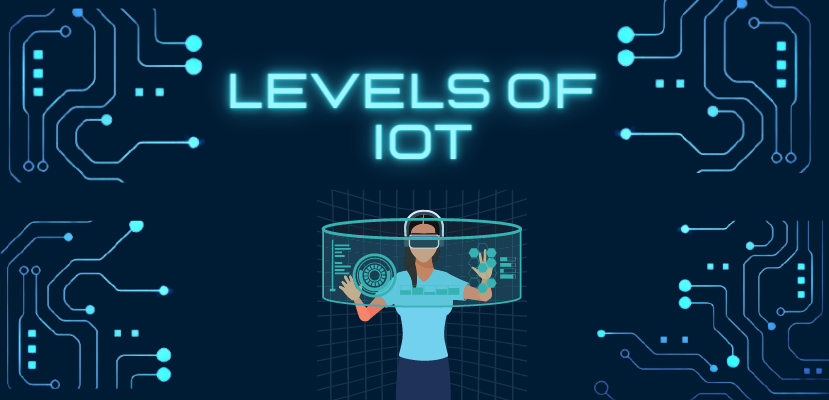
The architectural elements of the Internet of Things vary based on applications of use. Depending upon this fact, different levels are defined for the Internet of things system from Level 1 to 5, which also helps explain the different characteristics of IoT. Let’s discuss these levels with their elements, and I will also use examples of their usage. I am taking an example of an air conditioner and will monitor its temperature to understand the IoT levels.
IoT Level 1
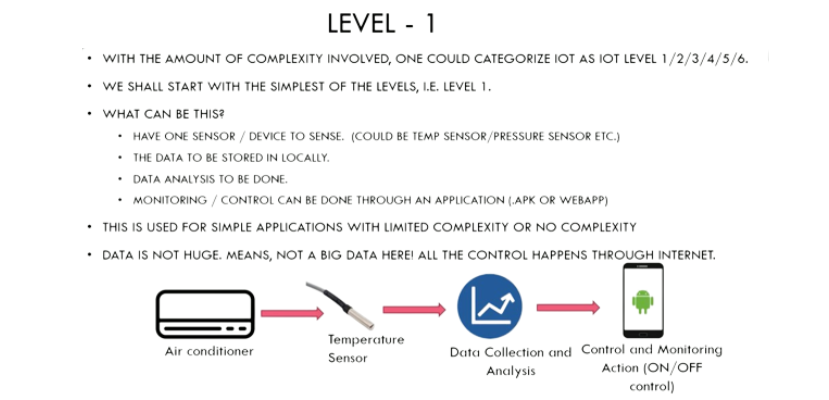
- Level 1 is the simplest of all Levels.
- This level consists of a sensor/device to sense(Could be a Temperature sensor/Pressure sensor), the Data to be stored Locally, Data Analysis to be done, Monitoring and Control can be done through the mobile app.
- It is used for simple applications with limited complexity or no complexity.
- Data is not that huge, so there is no big data here.
- All the controls happen through the Internet.
- In this level, we use physical devices for connections, so we can consider this level as part of Characteristics of IoT
IoT Level 2
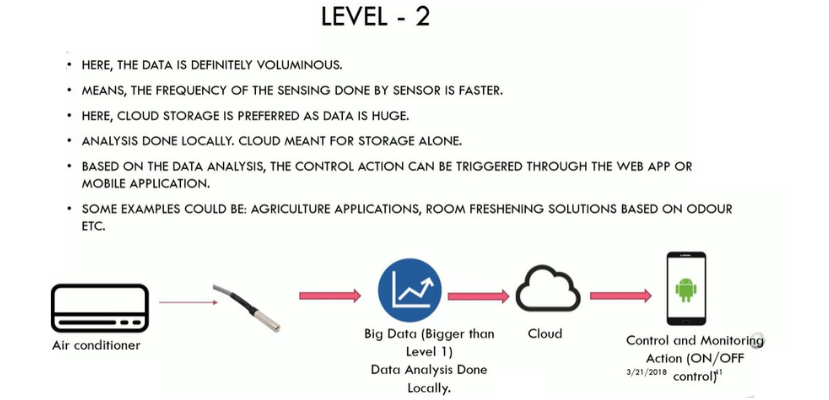
- The data is comparatively huge in level 2.
- As the Data is enormous, it means that the frequency of sensing done by the sensor is Faster.
- Because of the voluminous data, cloud storage is preferred.
- The analysis part is done locally; the cloud is only meant for storage
- Based on the Data Analysis, the control can be triggered through the web app or mobile application.
IoT Level 3
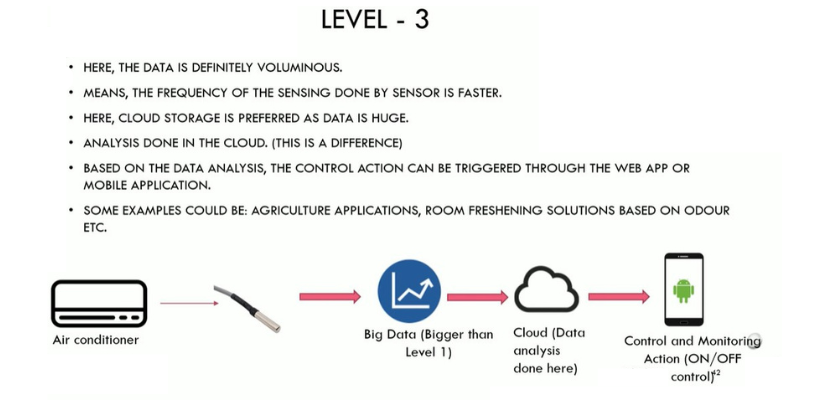
- As the Data is voluminous, the frequency of the sensing done by the sensor is faster
- Like level 2, cloud storage is preferred as the date is huge
- Most of the functionalities are the same except the data analysis; in this level, the data analysis is done in the cloud
- Based on the data analysis done in the cloud, a control action can be triggered through the mobile app
- A few examples of this level are Agriculture applications, room freshening solutions based on odor sensors etc.
- As Data analysis is done on vast data at this level, so we can consider this level an example of Charateristics of IoT which is Dynamic or Self-Adaptive.
IoT Level 4
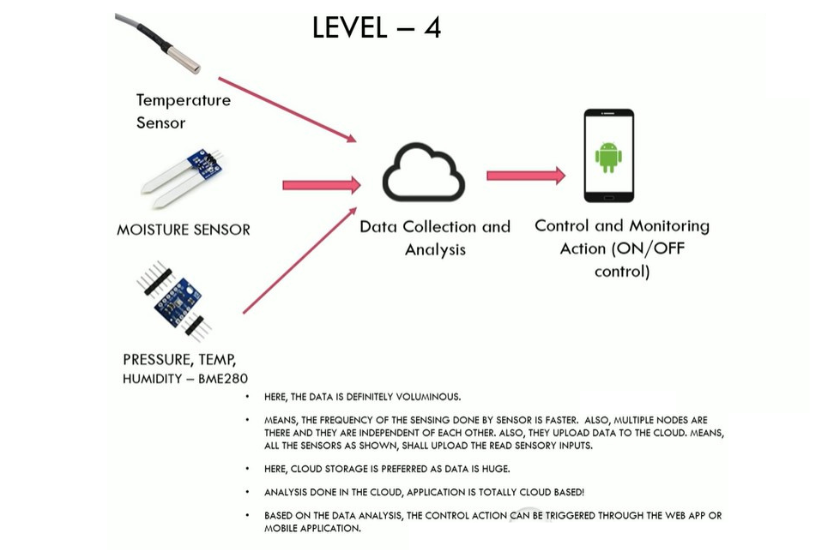
- The most important difference of this level is the usage of multiple sensors, which are independent of the others.
- All the data collected with these sensors’ help are uploaded to the cloud separately. Like levels 2 and 3, cloud storage is used in this level as well due to the requirement of massive data storage
- The data analysis is performed on the cloud based on which control action is triggered using the web or mobile app.
- Like level 3, this level can also be considered as an example of one of the Characteristics of IoT which is Dynamic or Self-Adaptive
IoT Level 5
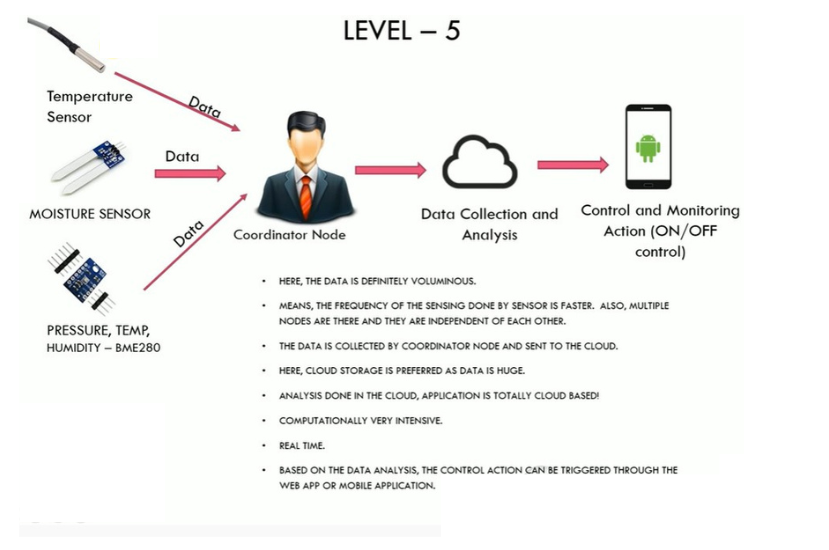
- This is the most important level: multiple sensors, coordinator nodes, data collection, analysis, control & monitoring app make this a little smart so this level can be an example of one of the Characteristics of the IoT named Intelligence
- Level 5 is more or less similar to level 4, which also has a large amount of data; hence, they are sensed using multiple sensors at a much faster rate.
- The data collection and data analysis are performed at the cloud level.
- Based on the analysis, control action is performed using mobile or web apps.
Summary
Finally, I would like to mention that the future of IoT is looking bright. With such new technologies and access to things that we would have never imagined in the past, IoT is growing day by day, and it will keep on making our life more accessible than before. This was all about the characteristics of IoT. With this blog on Characteristics of IoT; you have learned many new things about IoT, which will help you better understand IoT.
Frequently Asked Questions
IoT stands for Internet of Things. It is a way of multiple interconnecting systems with the help of internet devices which can be used in everyday objects by enabling them to send or receive data. There is a total of 7 Characteristics of IoT . Explanation of all the Characteristics of IoT is available in the above blog.
What are the characteristics of the Internet of Things?
There are many Characteristics of IoT in different places.
Below are a few Characteristics of IoT that are most commonly mentioned everywhere:
Connectivity
Intelligence and Identity
Scalability
Dynamic and Self-Adapting (Complexity)
Architecture
Safety
What is the most important characteristic of Internet of things?
The most important Characteristics of IoT is Communication.
Communication is an essential Characteristics of IoT . Often one device can use another device’s connectivity to establish network connectivity even when the second device is not connected to a network. This ability to communicate with each other makes IoT more efficient and scalable than other existing technologies.
What are the characteristics of Inernet of Thing (IoT) level 5?
Apart from the 7 Characteristics of IoT, IoT is also divided into 5 levels in terms of Architecture; these are;
Level 1, Level 2, Level 3, Level 4, and Level 5.
One of the essential Characteristics of IoT in level 5 is the introduction of a Coordinator to collect the big data and push it into the cloud, unlike other Levels. IoT architecture elements vary based on applications of use. Let us know to discuss some Characteristics of IoT of Level 5:
- Level 5 consists of multiple sensors, coordinator nodes, data analysis, and collection. It also has a control & monitoring app.
- It is more or less similar to level 4, which also has enormous data; hence, they are sensed using multiple sensors at a much faster rate and simultaneously.
- The process of data collection and data analysis is performed at the cloud level.
- Like the rest of the other levels, the control action is performed using a mobile app or web app based on analysis of big data sent by the coordinator notes.
What are the 2 key elements or characteristics of Internet of Things ?
All the elements or Characteristics of IoT are equally important because to create a good user-friendly system, we need all the attributes of the internet of things; however, if we talk about the key elements of IoT, these 4 elements come to my mind:
1) Sensors/Devices:
Sensors or devices collect data from the source and transfer it to the next level. The data could be anything, it could be as simple as temperature reading or as complex as a full video feed.
Sensors are generally used because multiple sensors can be used together or they can be part of a device that performs other works apart from sensing things. For example, a mobile phone is an electronic device that has multiple sensors like camera, accelerometer, GPS, etc, but the phone is not just a sensor since it can also perform many actions. So, sensors can be considered the key Characteristics of IoT
2) Connectivity:
One of the essential Characteristics of IoT is Connectivity. The data collected by sensors or devices are sent to the cloud where all the analysis happens, and based on that, the whole system works. These sensors or devices are connected through various methods like cellular, satellite, WiFi, Bluetooth etc.
Which one is not a characteristics of Internet of Things?
The Internet of things is famous for its self-adaptability and intelligence. It performs all the work without the intervention of humans.
So, if we talk about something which is not a part of the Characteristics of IoT, it is undoubtedly human intervention. Human intervention is hardly required in using smart home devices, and this is something that is least use so this can never be a characteristics of Internet of Things
What are the seven 7 basic elements of Internet of Things IoT ?
Apart from the Characteristics of IoT, there are few elements required in IoT; below are the 7 Basic Elements of IoT:
- Connected devices. Devices are the primary physical objects connected to the system
- Central Control Hardware. A Control Panel manages the two-way data traffic between different networks and protocols
- Data Cloud
- User interface
- Network Interconnection
- System Security
- Data Analytics.
What is the physical design of IoT?
The Physical design of an IoT system is the individual node devices and protocols used to create a fully functional IoT system. One of the Characteristics of IoT which is Connectivity has a very vital role in physical design as most of the physical connections or design lie in this characteristics.
Each node can perform many tasks like remote sensing, actuating, monitoring, etc. by relying on physically connected devices. It is also used for transmitting info through different types of connections which are wired or wireless.
Devices in IoT system can also be used for:
Building connections
Data processing
Providing storage
Providing interfaces
Providing graphical interfaces
What are the five advantages of the Internet of Things?
The Internet of things has many advantages in our daily lives. A few of the advantages are:
Minimal human effort
Time-Saving
Enhanced data collection
What are the 3 components of IoT?
The three main components of Internet of Things are:
Devices
Internet
Connectivity













